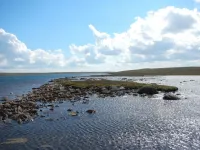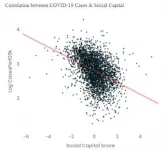Arctic stew: Understanding how high-latitude lakes respond to and affect climate change
2021-02-05
(Press-News.org) To arrive at Nunavut, turn left at the Dakotas and head north. You can't miss it--the vast tundra territory covers almost a million square miles of northern Canada. Relatively few people call this lake-scattered landscape home, but the region plays a crucial role in understanding global climate change. New research from Soren Brothers, assistant professor in the Department of Watershed Sciences and Ecology Center, details how lakes in Nunavut could have a big impact on carbon dioxide levels in the atmosphere, and it's not all bad news--at least for now. Brothers examined 23 years of data from lakes near Rankin Inlet. He noted a peculiarity--as the lakes warmed, their carbon dioxide concentrations fell. Most lakes are natural sources of carbon dioxide, but these lakes were now mostly near equilibrium with the atmosphere.
This was odd. The expected pattern is that warmer temperatures should trigger larger releases of greenhouse gases from lakes. In places like Alaska, centuries of accumulated plant material in the permafrost release a hoard of carbon as they thaw, and are consumed by microbes. Experiments have also shown that as waters warm, carbon dioxide production by microbes increases more quickly than carbon dioxide uptake by plants, throwing the system out of balance. Together, these processes should increase atmospheric greenhouse gas emissions from waterways, in theory anyway. So why not in Nunavut? There is no question that the first step in this Rube Goldberg machine is engaged ... the climate is warming. Why then, are the lakes near Rankin Inlet not belching out carbon?
Pulling on good, thick parkas, Brothers and his team visited the lakes and came up with a few ideas as to why this is happening. First, they note that much of Nunavut is on the Canadian shield--an ancient granitic bedrock where thin soils are unlikely to contain--and thus release--the massive stores of organic matter entering waterways elsewhere in the Arctic. Second, longer ice-free seasons might be changing the water chemistry and biology in ways that actually lower carbon dioxide concentrations, including longer growing seasons for plants (which take up carbon dioxide), and potentially better growing conditions for algae on the bottom of these shallow, clear lakes.
Does this mean that nature has come to the climate rescue? Likely not--other lakes around the world may still increase carbon dioxide emissions with warming, and the lakes in Nunavut might eventually catch up with them too. More likely, Brothers suggests that the link between ice cover duration and carbon dioxide concentrations might be buying us some time, before stronger positive feedbacks are unleashed between the planet's warming and its ecosystems. It may be a complicated process, but understanding this complexity helps scientists predict variations in how lakes are responding to--and influencing--climate change. It's a view under the hood, making planetary feedbacks and tipping points a little more predictable. While the long-term trajectory of greenhouse gas emissions from lakes is not settled, these results are an important piece of the puzzle in climate change science.
INFORMATION:
[Attachments] See images for this press release:

ELSE PRESS RELEASES FROM THIS DATE:
2021-02-05
A team of mathematicians from RUDN University found a way to reduce the size of a trained neural network six times without spending additional resources on re-training it. The approach is based on finding a correlation between the weights of neural connections in the initial system and its simplified version. The results of the work were published in the Optical Memory and Neural Networks journal.
The structures of artificial neural networks and neurons in a living organism are based on the same principles. Nodes in a network are interconnected; some of them receive a signal, and some transmit it by activating or suppressing the next element in the chain. The processing of any signal (for ...
2021-02-05
The discovery of an "Achilles heel" in a type of gut bacteria that causes intestinal inflammation in patients with Crohn's disease may lead to more targeted therapies for the difficult to treat disease, according to Weill Cornell Medicine and NewYork-Presbyterian investigators.
In a study published Feb. 3 in Cell Host and Microbe, the investigators showed that patients with Crohn's disease have an overabundance of a type of gut bacteria called adherent-invasive Escherichia coli (AIEC), which promotes inflammation in the intestine. Their experiments revealed ...
2021-02-05
Progressive vision loss, and eventually blindness, are the hallmarks of juvenile neuronal ceroid lipofuscinosis (JNCL) or CLN3-Batten disease. New research shows how the mutation associated with the disease could potentially lead to degeneration of light sensing photoreceptor cells in the retina, and subsequent vision loss.
"The prominence and early onset of retinal degeneration in JNCL makes it likely that cellular processes that are compromised in JNCL are critical for health and function of the retina," said Ruchira Signh, Ph.D., an associate professor in the Department of Ophthalmology and Center for Visual Science and lead author of the study which appears in the journal Communications Biology. "It is important to understand how vision loss is triggered in this disease, ...
2021-02-05
Washington, D.C.. -- The onset of the COVID-19 pandemic caused a sharp decline in living standards and rising food insecurity in developing countries across the globe, according to a new study by an international team of economists.
The study, published Feb. 5 in the journal Science Advances, provides an in-depth view of the health crisis's initial socioeconomic effects in low- and middle-income countries, using detailed micro data collected from tens of thousands of households across nine countries. The phone surveys were conducted from April through July 2020 of nationally and sub-nationally representative samples in Bangladesh, Burkina Faso, Colombia, Ghana, Kenya, Nepal, Philippines, Rwanda, and Sierra Leone. Across the board, study ...
2021-02-05
The largest single cell study to date of the childhood cancer, neuroblastoma, has answered important questions about the genesis of the disease. The researchers from the Wellcome Sanger Institute, Great Ormond Street Hospital (GOSH) and the Princess Máxima Center for Pediatric Oncology, discovered that all neuroblastomas arise from a single type of embryonic cell called sympathoblasts.
The study, published today (5 February 2021) in Science Advances, sought to understand why neuroblastomas range in severity, with some easy to treat and others having relatively low five-year survival rates. The fact that all neuroblastomas arise from sympathoblasts makes them an attractive ...
2021-02-05
Berkeley -- The onset of the COVID-19 pandemic last year led to a devastating loss of jobs and income across the global south, threatening hundreds of millions of people with hunger and lost savings and raising an array of risks for children, according to new research co-authored at the University of California, Berkeley.
The research, to be published Friday Feb. 5, 2021, in the journal Science Advances, found "staggering" income losses after the pandemic emerged last year, with a median 70% of households across nine countries in Africa, Asia and Latin America reporting financial losses. By April last year, roughly 50% ...
2021-02-05
Scientists led by Eliza Harris and Michael Bahn from the Institute of Ecology at the University of Innsbruck have succeeded in studying emissions of the greenhouse gas N2O under the influence of environmental impacts in an unprecedented level of detail. The study, which has now been published in Science Advances, is thus also a starting point for the creation of models that could predict future trends in the greenhouse gas emission dynamics of ecosystems under global climate change.
Nitrous oxide (N2O) is a potent greenhouse gas whose atmospheric growth rate has accelerated over the past decade. The largest share of anthropogenic N2O emissions results from the fertilization of soils with nitrogen, which is converted into N2O via various abiotic ...
2021-02-05
Genes that determine the shape of a person's facial profile have been discovered by a UCL-led research team.
The researchers identified 32 gene regions that influenced facial features such as nose, lip, jaw, and brow shape, nine of which were entirely new discoveries while the others validated genes with prior limited evidence.
The analysis of data from more than 6,000 volunteers across Latin America was published today in Science Advances.
The international research team, led from UCL, Aix-Marseille University and The Open University, found that one of the genes appears ...
2021-02-05
US counties with more social capital have fewer COVID-19 infections and deaths - perhaps because these communities have greater concern for the health of others.
INFORMATION:
Article Title: "How social capital helps communities weather the COVID-19 pandemic"
Funding: This research was supported by a grant from the Canadian Institutes of Health Research [CIHR, FRN-170368; PI: Cary Wu].
Competing Interests: The authors have declared that no competing interests exist.
Article URL: https://journals.plos.org/plosone/article?id=10.1371/journal.pone.0245135
...
2021-02-05
New research from Simon Fraser University shows that women's voices continue to be underrepresented in the media, despite having prominent female leaders across Canada and internationally. Researchers in SFU's Discourse Processing Lab found that men outnumber women quoted in Canadian news media about three to one. The findings from the team's Gender Gap Tracker study were published this week in the journal PLOS ONE.
The research team collected data from seven major Canadian media outlets from October 2018 to September 2020. Over the two-year period, 29 per cent of people ...
LAST 30 PRESS RELEASES:
[Press-News.org] Arctic stew: Understanding how high-latitude lakes respond to and affect climate change




